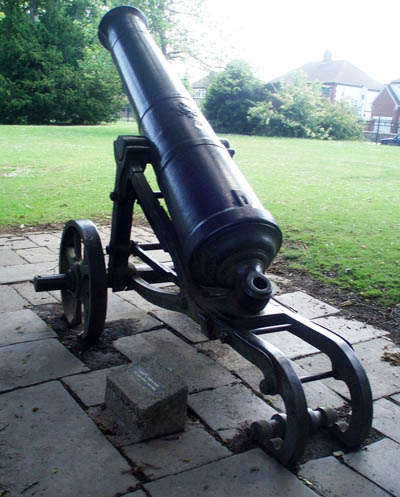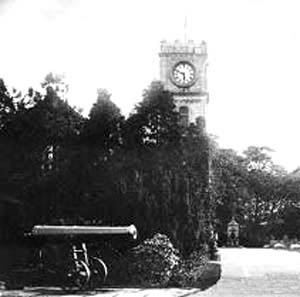
HOME





HOME
|

|

|

|

|
|
P R O F I L E |
||||
|
  CRIMEAN CANNONS - WHERE ARE THEY NOW?
CRIMEAN CANNONS - WHERE ARE THEY NOW?South Park Darlington County Durham England DL1 5TG War souvenir an emblem of Quaker defeat, by Chris Lloyd Changing Places: A 1920s postcard of South Park, showing the Crimean Cannon next to the lodge. It was later moved to near the aviary and at the time of writing the following was near the play area. Echo Memories tells why the Crimean Cannon in South Park symbolises a double humiliation for the pacifist Quaker Pease family of Darlington. The double-headed eagle on the brown grey gunmetal has been worn shiny and almost smooth by generations of young hands and feet that have clambered on the Crimean Cannon in Darlington's South Park. It was captured in the heat of bloody battle and transported home in triumph. But the Cannon's arrival in Darlington fired the first shot in a bitter political battle that lasted longer than the Crimean War itself. It was in late 1853 that war clouds began to gather over Europe. Tsar Nicholas I invaded southwards into what today we call Romania, but in those days was Moldovia and Wallachia - two provinces of the failing Ottoman Empire of Turkey. He even destroyed the Turkish navy at the Battle of Sinope. The French and the British piled in on behalf of the Turks, sending ultimatums to the tsar and more than 50,000 troops to the Black Sea. The Sardinians and then the Austrians came aboard with the allies, and in August 1854 the Russians withdrew. Yet the allies had all their boys bobbing about in the Black Sea spoiling for a scrap. So they decided to destroy the Russian naval base at Sebastopol, on the Crimean peninsula. They argued that Sebastopol was a threat to the Mediterranean and, anyway, the tsar had to be taught that his expansionism would not be tolerated. The allies landed on the Crimea on September 14. Six days later they won a battle at Alma, which meant 25,000 Russians were besieged in Sebastopol. As winter set in, the Russians tried to break out, drawing the allies into battles at Balaclava and Inkerman. It was at Balaclava, on October 25, that the infamous charge of the Light Brigade took place, which, 150 years later, is still a byword for military stupidity and blind obedience. Lord Raglan ordered Lord Lucan to stop the Russians from removing cannons they had captured up on some high ground. So Lord Lucan sent Lord Cardigan's Light Brigade charging down a valley, where they ran into a wall of fire from a Russian stronghold. A third of the 673 British cavalrymen fell as casualties. Despite this shocking incompetence, in October 1855, with the Tsar dead, the Russians abandoned Sebastopol - and their expansionist ambitions for at least a generation. They also abandoned their cannons and, in 1857, the British Government offered these spoils of war to any British town wanting a war memorial. In August 1857, the Darlington Board of Health voted to request two Cannons. It was a poorly attended meeting, with many of the town's ruling Quakers absent, and the motion passed with a majority of one. The Quakers, led by the Pease family, were implacable pacifists, and would never have voted for a memorial to a war. The Government sent a single cannon. Some wanted  it displayed in the Market Square; others, in the churchyard, as Middlesbrough had. During the debate, the Quakers regrouped and ensured the cannon was quietly forgotten about in a corner of South Park. There it remained until June 1860, when the cannon, fed up with its lot, wrote remarkable letters to local newspapers. it displayed in the Market Square; others, in the churchyard, as Middlesbrough had. During the debate, the Quakers regrouped and ensured the cannon was quietly forgotten about in a corner of South Park. There it remained until June 1860, when the cannon, fed up with its lot, wrote remarkable letters to local newspapers.
"The reptiles of the Earth take up their abode in what was once my chamber of destruction, " it thundered. Birds twitter saucily and with inquisitive eye peer into the dark recesses of my interior, and the worms hold nightly revels in the hollow region of my iron heart. Now, Mr Editor, who could stand it? I won't; I can't. . . if they don't move me soon, I'll blow up!" The issue blew up at the next board of health meeting. Fourteen members were present, at least nine from the Quaker camp including, in the chair, their leader Joseph Pease. The non-Quakers, led by John Wrightson, landlord of The Sun Inn, in Prospect Place, said the cannonís condition was an insult to all our brave boys who had sacrificed their lives in the Crimea. Pease disagreed. "Laying where it was, the chairman said he thought it was a most beautiful emblem of peace, for he had actually seen lambs feeding close to the muzzle of the gun, a remark which was received with loud laughter, " reported the Darlington Telegraph - an avowedly anti-Pease weekly paper. But the cannon remained surrounded by sheep. The following spring, in exasperation, it wrote once more, telling of the gruesome sights it had witnessed at Sebastopol. "After many ups and downs I landed in this country," it wrote. "I heard a delightful home had been provided for me in Darlington, which so pleased me that for a time I considered myself the most fortunate of Cannons. How sadly I was mistaken. The cruel neglect has wounded me to the quick, for although made of iron, my heart is not so hard as that of some human beings." The May 1861 board meeting discussed the cannon's predicament. Its supporters were outraged that the Peases could block a democratic decision for four years simply because they didn't like it. John Pease, Joseph's elder brother, was mocked when he said that mounting the cannon in the park would be an insult to every Russian. Before the matter could be put to the vote, Joseph Pease "vacated the chair". No vote could be taken. But, mysteriously, the Sebastopol gun was soon - quietly and without ceremony - sited in the park. There it stands today, with the tiniest of plaques to tell its story - possibly because the leading townspeople thought its story was too bloody, or possibly because it reminded them of their embarrassing defeat. It is noted that there was a four year delay between arrival and mounting the gun due to Quakers opposition. The funding of the mounting was raised a concert at the Theatre Royal on 21 March 1861. The Darlington cannon is recorded in the National Inventory of War Memorials at the Imperial War Museum ref. 41860 as located in South Park, NZ 280140. It is described as of bronze bearing the Russian Eagle. It also has some serial numbers, which may be confused for the cannons specifications as follows: number 24-01 120-11 1824-1 and Cyrillic script. It is likely that it is 24 pr calibre, 120 poods weight and 1824 the date of manufacture. The gun was almost scrapped during WWII but is now recorded on the Robins/Hennessy database as 19632 of 1824 a 24 pdr from the Alexandrovski Works. Further reading: Darlington Telegraph 6 April 1861, p.3; Darlington and Stockton Times 14 Jan 1860; Northern Echo 20 Jan 1991. Email: cannon@thespas.co.uk (click here to send an email) ADDITIONAL INFORMATION  REGION England - Northern THE FEATURES PRESENT Crimean Cannon Location, past or present |
||||
|